Challenging torrential rains countered by cooperative bats in Costa Rica
Merlin and MTBC team members spent 19 days in Costa Rica last November on a filming trip for “Bat City” with its Director and Emmy
For the past week we’ve been mist netting for bats, mainly Lesueur’s wing-gland bats (Cistugo lesueuri) at the Sterkfontein Dam and Nature Reserve in the Free State Province of South Africa which lies on the northeastern side of the Drakensberg Escarpment, about a four-hour drive southeast of Pretoria. The Kingdom of Lesotho lies west of the Drakensberg mountain range. It’s a tiny nation of about 2 million mainly Basotho people atop the windswept escarpment, reached by four-wheel drive vehicles on only the one road. The African subcontinent’s highest peak is Thabana Ntlenyana (beautiful little mountain) in the Drakensberg Mountain Range, an impressive 11,417 feet (3,480m) above sea level.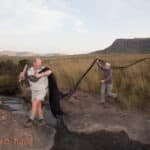
Each night we set up multiple nets in different parts of the reserve that look like they have potential for finding our bat. But winter is setting in, and we’ve been hammered by gale-force winds and temperatures around 40 degrees F (4 C), conditions where most bats are not active.
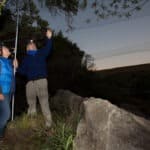 Twice we mistook a Cape serotine (Eptesicus capensis) for a Lesueur’s wing-gland bat (Cistugo lesueri), only to find out the disappointing truth upon closer inspection back at our chalet. The two species are easily confused in the field, however they actually belong to different families. The genus Eptesicus is found nearly everywhere and belongs to the family Vespertilionidae. Cistugo has recently been recognized to represent a new family, the Cistugonidae. Despite its distinctiveness, based on skull and genetic characters, it is only recognizable in the field by its pointed tragus, compared to the blunt ones of Eptesicus, sometimes not easily seen in a very small bat when being extracted from a mist net. Merlin has already photographed all 18 of the world’s other bat families, so he wanted to add this one once it was recognized.
Twice we mistook a Cape serotine (Eptesicus capensis) for a Lesueur’s wing-gland bat (Cistugo lesueri), only to find out the disappointing truth upon closer inspection back at our chalet. The two species are easily confused in the field, however they actually belong to different families. The genus Eptesicus is found nearly everywhere and belongs to the family Vespertilionidae. Cistugo has recently been recognized to represent a new family, the Cistugonidae. Despite its distinctiveness, based on skull and genetic characters, it is only recognizable in the field by its pointed tragus, compared to the blunt ones of Eptesicus, sometimes not easily seen in a very small bat when being extracted from a mist net. Merlin has already photographed all 18 of the world’s other bat families, so he wanted to add this one once it was recognized.
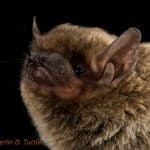
These bats have seldom been caught, and previously only in South Africa’s summer. We hoped to still find them in fall. Unfortunately, the cold weather arrived early, precluding our ability to find them despite the expert and tireless efforts of our South African colleagues: Ernest Seamark, Teresa Kearney, Johan Watson and Leon Labuschagne. It’s difficult to imagine having a better informed, harder working team. Night after night they led netting efforts, often under extremely miserable conditions. Last night Merlin was forced to wear both his down vests, a long-sleeved fleece, long underwear and a windbreaker, and he was still cold. All of us were! Thanks to our wonderful and much appreciated team, Merlin was able to photograph four species, despite trying circumstances.
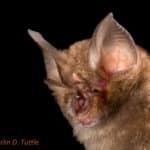
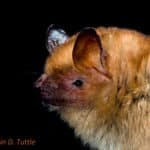
Love our content? Support us by sharing it!
Merlin and MTBC team members spent 19 days in Costa Rica last November on a filming trip for “Bat City” with its Director and Emmy
Bats can use sounds in many complex ways. They can sing and even have different dialects… When imagining a bat, the first thoughts that come
Thanks to all the Join the Nightlife: Bats and Agriculture attendees who joined us out in the field this year! Guests got hands-on experience with
Supporter and friend of MTBC, Australian conservation and animal welfare photojournalist Doug Gimesy, had his images recognized in two categories at the recent Siena International
2024 © Merlin Tuttle’s Bat Conservation. All rights reserved.
Madelline Mathis has a degree in environmental studies from Rollins College and a passion for wildlife conservation. She is an outstanding nature photographer who has worked extensively with Merlin and other MTBC staff studying and photographing bats in Mozambique, Cuba, Costa Rica, and Texas. Following college graduation, she was employed as an environmental specialist for the Florida Department of Environmental Protection. She subsequently founded the Florida chapter of the International DarkSky Association and currently serves on the board of DarkSky Texas. She also serves on the board of Houston Wilderness and was appointed to the Austin Water Resource Community Planning Task Force.
Michael Lazari Karapetian has over twenty years of investment management experience. He has a degree in business management, is a certified NBA agent, and gained early experience as a money manager for the Bank of America where he established model portfolios for high-net-worth clients. In 2003 he founded Lazari Capital Management, Inc. and Lazari Asset Management, Inc. He is President and CIO of both and manages over a half a billion in assets. In his personal time he champions philanthropic causes. He serves on the board of Moravian College and has a strong affinity for wildlife, both funding and volunteering on behalf of endangered species.